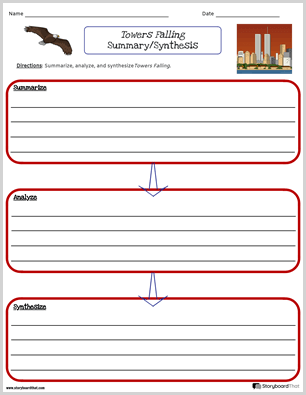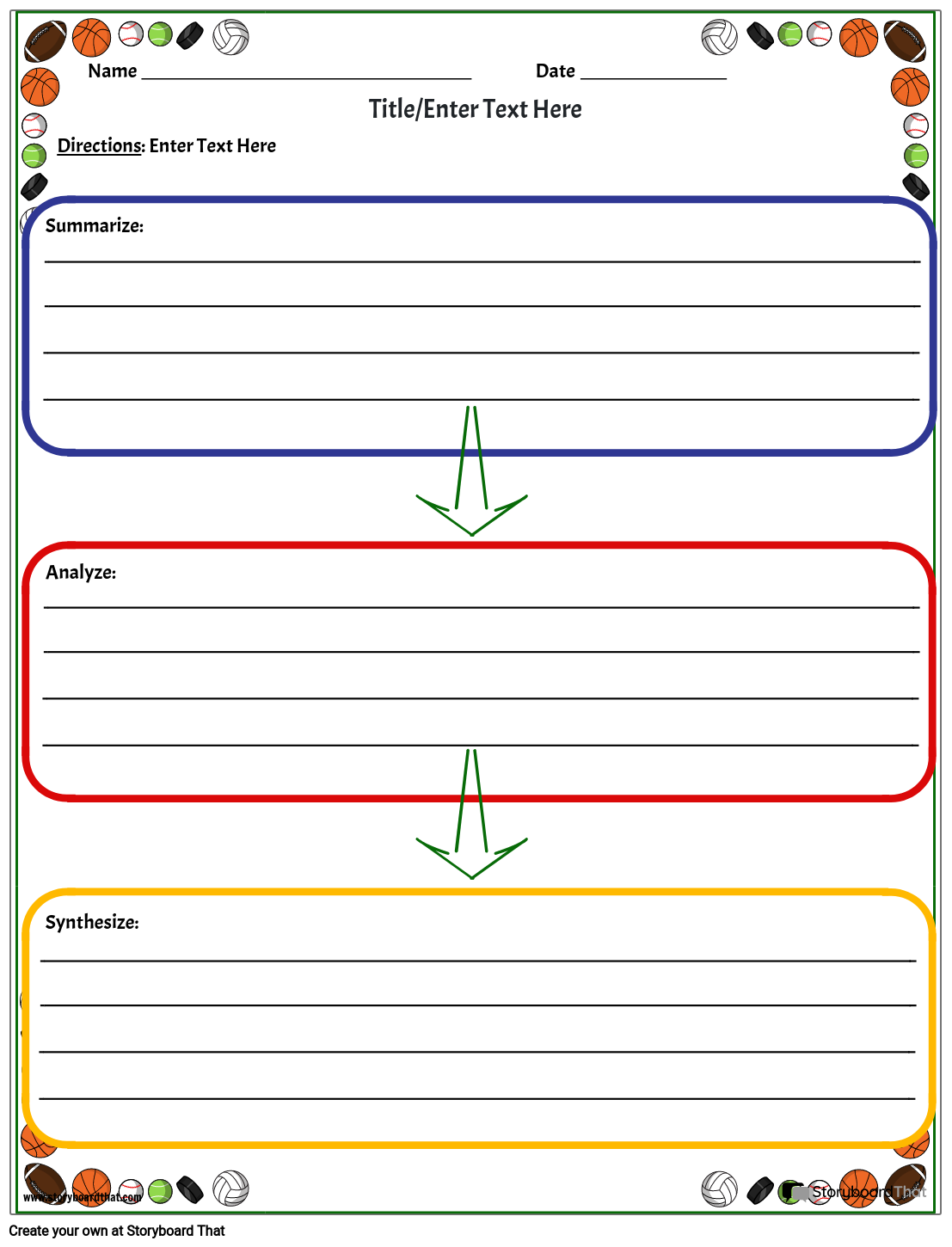Customize Summary & Synthesis Templates
If you're assigning this to your students, copy the worksheet to your account and save. When creating an assignment, just select it as a template!

What is a Summary/Synthesis Worksheet?
In today's world, we are surrounded by an overwhelming amount of information. Whether it's news articles, academic journals, or social media posts, we are constantly bombarded with information that we need to digest and make sense of. This is where synthesizing information comes into play. So what is synthesizing information? It is the process of combining multiple sources of information to create a new understanding of a topic. It is an important skill that can help learners improve their reading comprehension and critical thinking abilities.
One effective way to teach students how to synthesize information is by using worksheets. Our worksheets ask students to paraphrase key information, analyze the importance of that information, and synthesize or draw a conclusion about that information. A summary deals with one text, whereas a synthesis is a response to multiple texts. These worksheets help differentiate between the two and learn how to apply each technique effectively. Summary analysis and information synthesizing worksheets are designed to help students identify the main ideas of a text and condense them into a brief summary. Synthesis worksheets, on the other hand, require students to analyze multiple sources of information and synthesize them into a new, cohesive understanding of the topic.
Why are They Important and How are They Best Used?
A summary synthesis draws on more than one source of information in order to analyze the information and reach a conclusion. These assignments can be used to craft literature reviews, articles, or source evaluations. They can also be used in synthesis papers where writers must write on one topic while drawing from a wide range of sources.
For example, let's say your class reads three different articles on the benefits of exercise. A summary worksheet might ask them to identify the main benefits mentioned in each article and write a brief summary of each. A synthesis worksheet, on the other hand, might ask them to analyze the information from all three articles and synthesize a new understanding of the benefits of exercise, taking into account all three perspectives.
Summary vs. Synthesis
These are two important skills that students need to develop in order to understand and analyze information effectively. The difference between synthesis and summary is more nuanced than its main similarity which is that both involve condensing information into a more concise form. There are important differences between the two.
For example, imagine you are reading an article about climate change. A summary of the article might say:
"This article discusses the effects of climate change on weather patterns and sea levels. It argues that human activity is largely responsible for these changes and that urgent action is needed to mitigate the impacts of climate change on the environment and society."
This captures the key points of the article in a concise and straightforward manner.
Synthesis, on the other hand, involves taking multiple pieces of information and combining them into a new and original whole. It is a way of making connections between different sources of information and creating something new and unique from them. Synthesis can be found in a wide range of contexts, from academic research papers to creative writing, and is often used as a way of developing new insights or ideas. The examples below illustrate the differences.
Summary vs Synthesis Example
For example, imagine you are researching the impact of social media on mental health. You might read multiple studies that explore different aspects of this topic, such as the effects of social media on self-esteem, the relationship between social media use and depression, and the impact of social media on sleep patterns. Through synthesis, you might combine these different pieces of information to develop a new understanding of the topic, such as with the example below:
"Social media has a complex relationship with mental health, with studies showing that it can impact self-esteem, contribute to depression, and disrupt sleep patterns. While there is no clear consensus on the overall impact of social media on mental health, it is clear that it is a topic that requires further research and attention."
This synthesis combines multiple pieces of information to create a new and nuanced understanding of the topic, incorporating insights from multiple sources.
They are both important skills that students need to develop in order to effectively understand and analyze information. Both skills are valuable in a wide range of contexts, from academic research to everyday life, and can help students to better understand complex ideas and concepts.
Creating a Successful Lesson Plan
To create a successful lesson plan, it is important to start with clear learning objectives. These objectives should outline what students will be able to do by the end of the lesson, such as, "Students will be able to differentiate between summary and synthesis and apply each technique effectively."
Once the learning objectives are established, you can begin to plan the activities that will help students achieve those objectives. One effective way to teach synthesis is by using graphic organizers that help students organize their thoughts and analyze multiple sources of information. For example, a Venn diagram can be used to compare and contrast information from two different sources. A T-chart can be used to compare and contrast two different perspectives on a topic.
It is also important to include a variety of primary sources in the lesson plan. Primary sources, such as original documents or firsthand accounts, can provide students with a deeper understanding of a topic and allow them to form their own opinions.
Finally, it is important to provide kids with analysis worksheets that help them apply the techniques they have learned. These worksheets should ask students to analyze a text and identify the main ideas, supporting details, and any biases or assumptions present in the text.
There are many free summarizing worksheets and synthesizing information worksheets available online that can help teachers create effective, detailed lesson plans. These worksheets can be tailored to fit the needs of each class and can be used to reinforce the skills that have been taught in class.
In conclusion, synthesizing information is an important skill that can help kids become better readers and critical thinkers. By using worksheets, graphic organizers, primary sources, and analysis worksheets, teachers can create effective lesson plans that teach their class how to synthesize information from multiple sources and create a new understanding of a topic.
Planning a Worksheet
- Identify the Text or Topic: Choose a text or topic that you want your class to summarize or synthesize.
- Determine the Purpose: Decide on the purpose of the worksheet. Is it to check for comprehension or to encourage critical thinking and analysis?
- Identify the Main Ideas: Identify the main ideas or themes of the text or topic. This will help you create prompts or questions for the worksheet.
- Determine the Format: Decide on the format. Will it be a written response or a visual representation, such as a storyboard or mind map?
- Create Prompts or Questions: Create prompts or questions that guide students in summarizing or synthesizing the information. These should be clear and concise, and encourage critical thinking and analysis.
- Provide Scaffolding: Provide scaffolding for students who may need additional support. This can include the use of synthesis graphic organizers, sentence starters, or sentence frames.
- Revise and Edit: Review and revise as necessary. Ensure that the prompts or questions are clear and that the format is appropriate for the task.
- Use as a Teaching Tool: Use the worksheet as a teaching tool to reinforce important concepts and skills. Provide feedback to students and use their responses to guide future instruction.
By following these steps, you can create effective worksheets that engage and challenge your students while supporting their learning.
How to Make A Summary and Synthesis Worksheet
Choose One of the Premade Templates
We have lots of templates to choose from. Take a look at our example for inspiration!
Click on "Copy Template"
Once you do this, you will be directed to the storyboard creator.
Give Your Worksheet a Name!
Be sure to call it something related to the topic so that you can easily find it in the future.
Edit Your Worksheet
This is where you will include directions, specific questions and images, and make any aesthetic changes that you would like. The options are endless!
Click "Save and Exit"
When you are finished with your worksheet, click this button in the lower right hand corner to exit your storyboard.
Next Steps
From here you can print, download as a PDF, attach it to an assignment and use it digitally, and more!
Even More Storyboard That Resources and Free Printables
- Critical Analysis Essay Outlines
- Thesis Statement Worksheets
- Point of View Worksheets
- Character Analysis Worksheet
- First Day of School Templates
- Checklist Templates
Happy Creating!
Frequently Asked Questions About Summary and Synthesis Worksheets
What is synthesizing information and what is the difference between synthesis and summary?
Synthesizing information involves combining multiple sources to create a new, integrated understanding. It goes beyond summarizing by analyzing each source and connecting the dots to create something new. The key difference between the two is that synthesis creates something new by combining information from multiple sources, while summary condenses information from a single source into a brief statement.
How can summary and synthesis worksheets be used in the classroom?
These worksheets are valuable tools for promoting student learning. They can improve reading comprehension, develop critical thinking skills, reinforce learning objectives, and assess student understanding. By identifying the main ideas of a text and synthesizing information from multiple sources, students can create a new understanding of a topic and support their arguments with evidence. Worksheets can be adapted to meet the needs of different students and are effective for promoting learning across various learning styles.
What are the benefits of using storyboards to teach summary and synthesis?
Storyboards offer several benefits for teaching. They provide visual representations that aid in understanding and remembering key concepts, engage students creatively, allow synthesis from multiple sources, develop critical thinking skills, and promote collaboration among students. Storyboards offer an exciting and engaging classroom environment that can support student learning and be tailored to different learning preferences.
In which academic subjects can the use of summary and synthesis worksheets and storyboards be beneficial?
These worksheets and storyboards can be used in various subjects to improve students' critical thinking skills and understanding of complex concepts. Examples include ELA, where students can summarize novels and articles, social studies where students can synthesize information from primary and secondary sources, science where students can visualize data to identify patterns, and math where students can create visual representations of word problems.
© 2026 - Clever Prototypes, LLC - All rights reserved.
StoryboardThat is a trademark of Clever Prototypes, LLC, and Registered in U.S. Patent and Trademark Office
















